article_detail
Balsapintada in Fuente Álamo
Balsapintada is one of the outlying districts of Fuente Álamo
Balsapintada is located 7 kilometres south of Fuente Álamo, falling within the municipality of the same name, and 31 kilometres south of the city of Murcia.
As with many of these rural settlements, it owes its existence to a water supply, a spring which attracted settlers and the transhumance farmers who passed through with flocks of sheep in search of pasture. Indeed, its name comes from a "balsa" or trough built to give them water, this particular one being painted plue: hence the name "painted trough" or "balsa pintada".
There is a square at the entrance to the village with a water feature and this is the location of the original water source. In the past it was modelled as a Moorish garden, but it was altered during 2011.
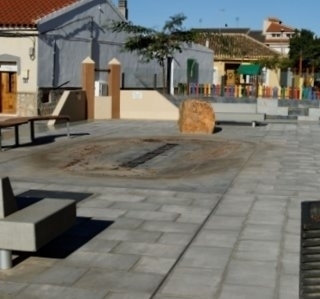 The first real evidence of any human activity in the area is Roman, and there was certainly Moorish activity around the watering hole, although it was not until the Middle Ages that the village gained importance as a strategic watering stop-off point. Balsapintada lay on a route known as “La Mesta”, which crossed the Campo de Cartagena in the later Middle Ages and for several hundred years large herds of animals were driven through the area as transhumance farming became dominant in the area. During the winter large herds were brought to Murcia from north of Spain and Balsapintada was an important milestone on their route.
The first real evidence of any human activity in the area is Roman, and there was certainly Moorish activity around the watering hole, although it was not until the Middle Ages that the village gained importance as a strategic watering stop-off point. Balsapintada lay on a route known as “La Mesta”, which crossed the Campo de Cartagena in the later Middle Ages and for several hundred years large herds of animals were driven through the area as transhumance farming became dominant in the area. During the winter large herds were brought to Murcia from north of Spain and Balsapintada was an important milestone on their route.
The village trully emerged during the 17th century, when the risk of pirate attacks from the coast diminished and the whole area was repopulated..
Balsapintada in the 19th and 20th centuries
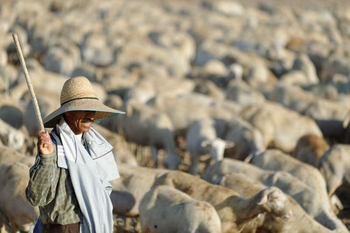 Until 1836 Balsapintada belonged to the city of Murcia, but in that year it became part of Fuente Álamo. The following year it even requested independence from Fuente Álamo, but this was never achieved. In terms of cultural activity a key date in the village’s history was 6th August 1863, when Pedro Sánchez Picazo, a noted painter specializing in images of flowers, was born.
Until 1836 Balsapintada belonged to the city of Murcia, but in that year it became part of Fuente Álamo. The following year it even requested independence from Fuente Álamo, but this was never achieved. In terms of cultural activity a key date in the village’s history was 6th August 1863, when Pedro Sánchez Picazo, a noted painter specializing in images of flowers, was born.
In 1906 two schools were founded, one for boys and the other for girls, and the two were combined in 1950. The population has grown considerably since the village was first established, with the notable exception of the 1980s, when the number of inhabitants dropped sharply. In 1940 there were 1,346 locals, and this had increased to 1,606 by 1960. In recent years the village has grown again, due in large part to the number of immigrants seeking work in the fields: in 2004 there were 1,719 inhabitants.
The development of the local economy
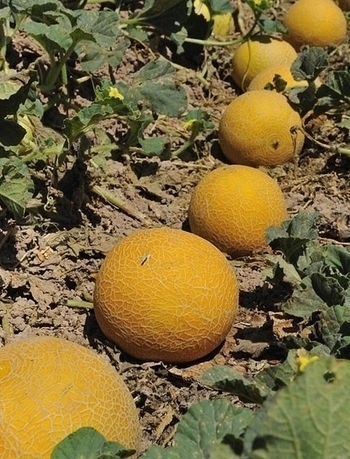 Agriculture was revolutionized in much of the Region of Murcia during the late 20th century by the completion of the Tajo-Segura water supply canal, which revolutionised the production of crops and the economy in and around Balsapintada.
Agriculture was revolutionized in much of the Region of Murcia during the late 20th century by the completion of the Tajo-Segura water supply canal, which revolutionised the production of crops and the economy in and around Balsapintada.
Nowadays there is four times as much irrigated farming as arid crop cultivation, and the population has been boosted by immigrants and those who work on the surrounding agricultural concerns. Farming has become a vital element in the economy throughout Fuente Álamo, but there is also a great deal of intensive livestock production within the municipality, especially pigs and chickens.
However, Balsapintada has also become the hub for the region´s agricultural haulage industry and road haulage of the products grown locally is now one of the cornerstones of the local economy.
This has changed the face of its role within the society and economy of the municipality of Fuente Álamo and of the way of life in the village, and each year the importance of the haulage industry is honoured in the "Day of the Lorry Drivers", which forms part of the main Fiestas Patronales celebrated in July.
The church of La Purísima in Balsapintada
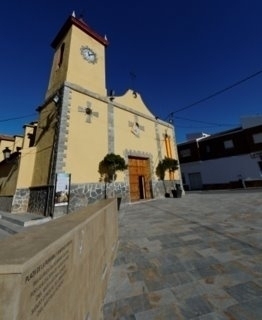 When it was built, the church of Balsapintada was dedicated to the Purísima Concepción, or the Immaculate Conception. The first thing that stands out about the building is the original way in which colours are combined on the façade: the walls are ochre, and this is counterpointed by reliefs around the windows and on the roof in red.
When it was built, the church of Balsapintada was dedicated to the Purísima Concepción, or the Immaculate Conception. The first thing that stands out about the building is the original way in which colours are combined on the façade: the walls are ochre, and this is counterpointed by reliefs around the windows and on the roof in red.
As well as the colour scheme, another interesting feature is the way in which the lower part of the wall is picked out in flat stone. This is true not only of the façade but also of the rest of the outside of the building, and the same material is used in the cross-shaped decorations above the three small circular windows at the front of the church. The building stands on its own, surrounded by four streets, and in front of it there is a small square with impressive trees which are illuminated at night.
The inside of the church is simply decorated, the most noticeable feature being the golden cornice which separates the main walls from the vault. This runs all around the building, and there are inscriptions in Latin just below it.
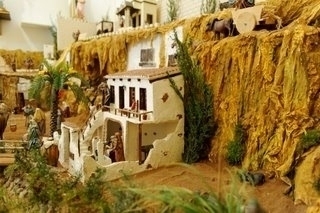 At Christmas, the church hosts the municipal Belén, a nativity scene which won the regional prize in 2011 as the best of its kind in the Region of Murcia. The scene features many of the local agricultural traditions and shows locals as actors in a Bethlehem nativity situation.
At Christmas, the church hosts the municipal Belén, a nativity scene which won the regional prize in 2011 as the best of its kind in the Region of Murcia. The scene features many of the local agricultural traditions and shows locals as actors in a Bethlehem nativity situation.
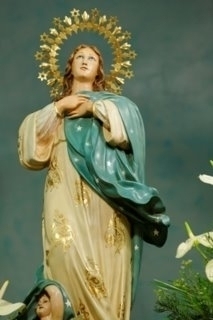 Balsapintada’s Centro Socio-Cultural was opened in 1995 to serve as a centre for the majority of the cultural activity of the district, including theatrical, musical and educational programs.
Balsapintada’s Centro Socio-Cultural was opened in 1995 to serve as a centre for the majority of the cultural activity of the district, including theatrical, musical and educational programs.
Initially it consisted of just a central single-storey building, which housed the canteen, the Aula de Libre Acceso and the reading room. The building was later extended to house the “El Paraíso Azul” retired people’s association and the local Women’s Institute, and these are now in two annexes next to the main block. These new areas include another canteen and two multi-purpose rooms.
The exterior of the building is painted white, and the whole complex is known locally as “La Casa Blanca”.
The local fiestas are held in honour of Santiago Apóstol, lasting for a fortnight during the month of July. and ending on the Saint’s Day, 25th July.
El Día del Camionero (Lorry Drivers Day), 18th July
 The truck driver has been one of the emblems of Balsapintada ever since the district became an important road haulage centre, with much of the district’s economy depending on this sector.
The truck driver has been one of the emblems of Balsapintada ever since the district became an important road haulage centre, with much of the district’s economy depending on this sector.
The “Día del Camionero” is celebrated during the period of the fiestas in honour of Santiago Apóstol, but is treated as a separate event in its own right. As well as a celebration of the prosperity brought to Balsapintada by road haulage, it also serves as a day of remembrance for those who have lost their lives on the road.
This unusual local fiesta has been held for over 30 years and seems to become more and important every year. Specialist transport and haulage magazines always devote column inches to it during the build-up to 18th July, and many of the leading international truck companies such as Mercedes, Daf, Volvo and Man make a point of being present during the festivities.
Location
Click for map, Balsapintada, Fuente Álamo
For more information about the whole municipality, click Fuente Álamo.
article_detail
Contact Spanish News Today: Editorial 966 260 896 /
Office 968 018 268












